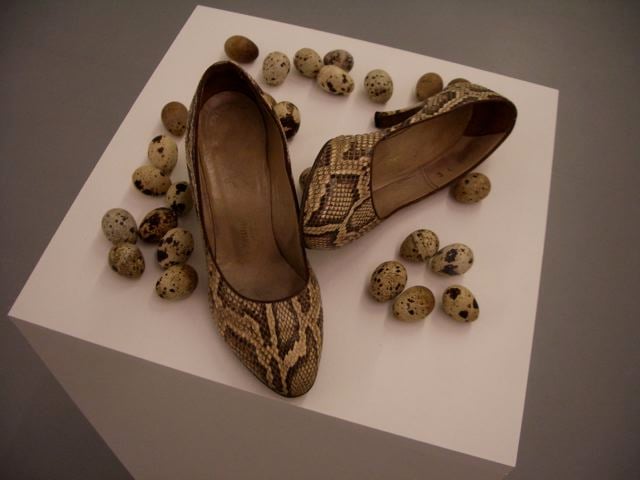The Simpson Verdict
2002 - Film & Video (Film & Video)
2:50 minutes (looped)
Kota Ezawa
The Simpson Verdict is a three-minute animation by Kota Ezawa that portrays the reading of the verdict during the OJ Simpson trial, known as the “most publicized” criminal trial in history. In 1995, OJ Simpson—a well-known American football player—was accused of the murders of his ex-wife Nicole Brown Simpson and her friend Ronald Goldman. Based on the courtroom footage, Ezawa uses his signature style to create an abstract and graphically simplified echo of what happened in the room. This re-enactment reflects the uncanny feeling of the trial footage, which was depicted solely through fixed close-up recordings (there was only one camera allowed in the courtroom). Zeroing in on the facial expressions of Simpson and his lawyers, Ezawa makes use of simple facial gestures, such as the movement of eyes and eyebrows, to highlight the emotional intensity of the moment. These expressions are minimal, due in part to the limitations of the artist’s animation technique. As the artist subtracts other visual cues, the most obvious way to distinguish people becomes their skin color, leaving the viewer with a comment on the racial implications of the trial and the unreliable nature of the verdict.
Kota Ezawa borrows images from the news, art history, and pop culture and turns them into cartoon-like stories. He produces flat and two-dimensional imagery via his light-boxes, works on paper, and animations. These works are often inspired by important moments in history, such as the assassinations of John F. Kennedy and Abraham Lincoln, the O.J. Simpson trial, and media coverage of former National Football League (NFL) player Colin Kaepernick kneeling during the national anthem as a symbol of protest. Ezawa’s animations, which he describes as “moving paintings,” make use of a labor-intensive technique that requires the artist to recreate each frame with close attention, producing hundreds of illustrations via digital drawing and animation software. He is best known for a signature style that embraces vibrant colors and simple forms, stripping detail from images to leave only essential attributes and environments. This reductive technique does not diminish the power of the image, as it turns to the familiar historical or cultural context to fill any gaps left by the artist’s erasures. However, the gesture also invites viewers to think about how these erasures might destabilize the reliability of public memories, highlighting the faulty process of collective remembering and what it tends to overlook.
Colors:
Related works featuring themes of: » Animation, » Appropriation Art, » Art and Technology, » Collage, » German

© » KADIST
Wong Wai Yin
2021Drawn from the widely circulated images of protests around the world in support of women rights and racial equality, the phrase I can’t believe we are still protesting is both the title of Wong Wai Yin’s photographic series and a reference to similar messages seen on protest signages...

© » KADIST
Clemens von Wedemeyer
2003Silberhöhe , directed at Halle, located in the former GDR (German Democratic Republic), is the name of a neighborhood on the outskirts of the city, which was built in the 70’s and could accommodate more 40,000 people...

© » KADIST
Martin Kippenberger
1989Untitled is a work on paper by Martin Kippenberger comprised of several seemingly disparate elements: cut-out images of a group of dancers, a japanese ceramic vase, and a pair of legs, are all combined with gestural, hand-drawn traces and additional elements such as a candy wrapper from a hotel in Monte Carlo and a statistical form from a federal government office in Wiesbaden, Germany...

© » KADIST
Chen Shaoxiong
2006After engaging primarily with video and photography for more than a decade, Chen turned to painting to explore the issue of urban change and memories—both personal and collective...

© » KADIST
Annette Kelm
2014In Stilleben mid Zierlauch ( Still Life with Aluminum) Annette Kelm utilizes visual juxtaposition to bring together a gridded aluminum backdrop, a pot with a vaguely indigenous pattern on it, and two purple dandelions...

© » KADIST
Hans-Peter Feldmann
The types of objects Feldmann is interested in collecting into serial photographic grids or artist’s books are often also found in three dimensional installations...

© » KADIST
Qiu Anxiong
2011A Portrait: Covering and Cleaning is an installation of six black-and-white video projections...

© » KADIST
Wong Wai Yin
2021Drawn from the widely circulated images of protests around the world in support of women rights and racial equality, the phrase I can’t believe we are still protesting is both the title of Wong Wai Yin’s photographic series and a reference to similar messages seen on protest signages...

© » KADIST
Wolfgang Tillmans
2017Wolfgang Tillmans initiated the ongoing series Faltenwurf in 1989, representing compositions of unused clothing, with special attention paid to the ways in which they drape and fold...

© » KADIST
Eko Nugroho
2009Nugroho’s installations and performances have their roots in the shadow puppet rituals in Indonesia, particularly the Javanese Wayang tradition whose essence is in the representation of the shadows...

© » KADIST
John Baldessari
1997In One Must , an image of a pair of scissors, accompanied by the words of work’s title, poses an ominous question about the relationship between the image and the text...

© » KADIST
Thomas Kilpper
2009These two images come from the series called “State of Control” which Kilpper made in the building formerly occupied by the Stasi in Berlin...








